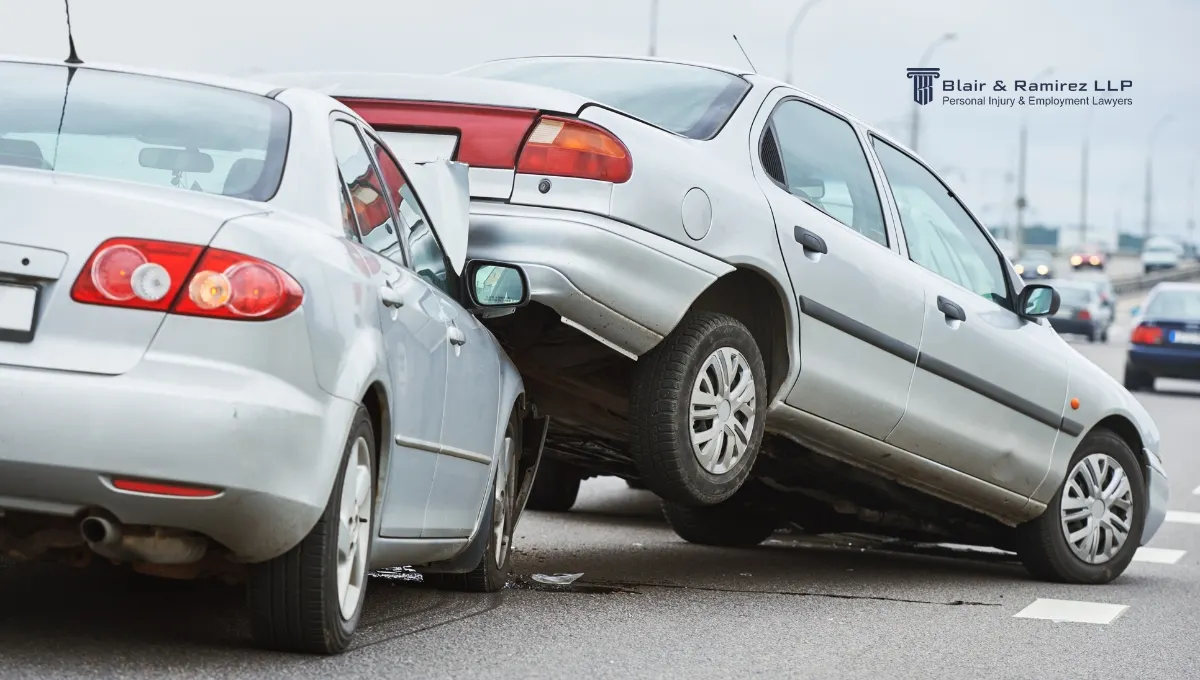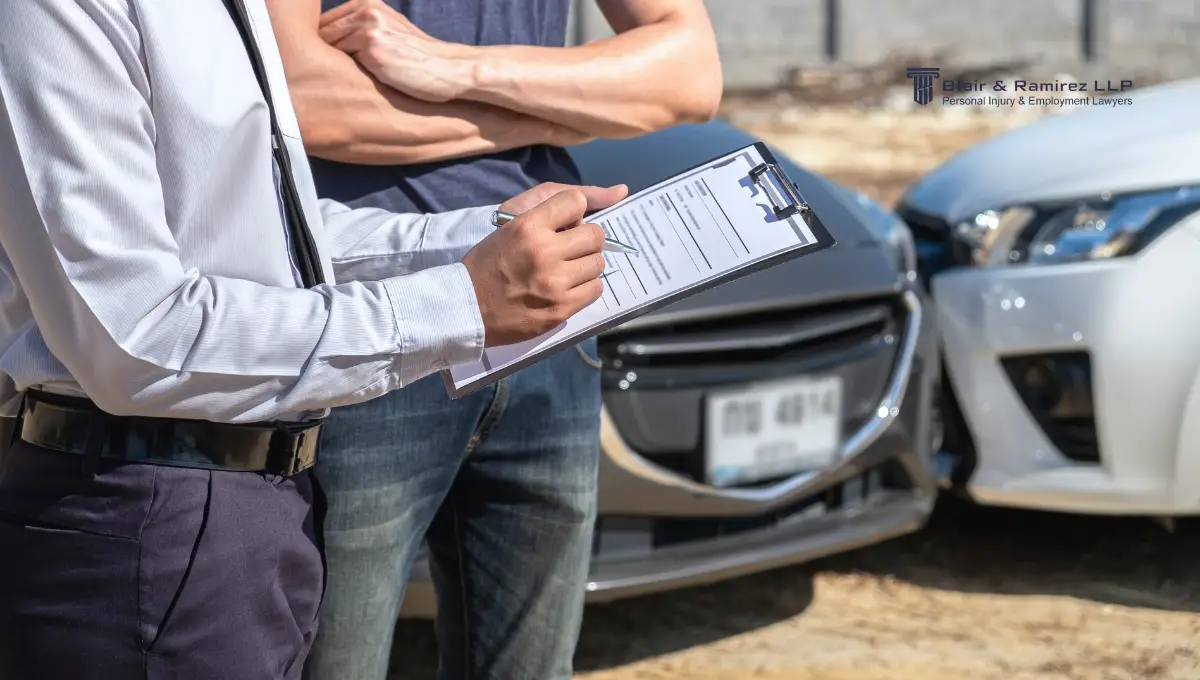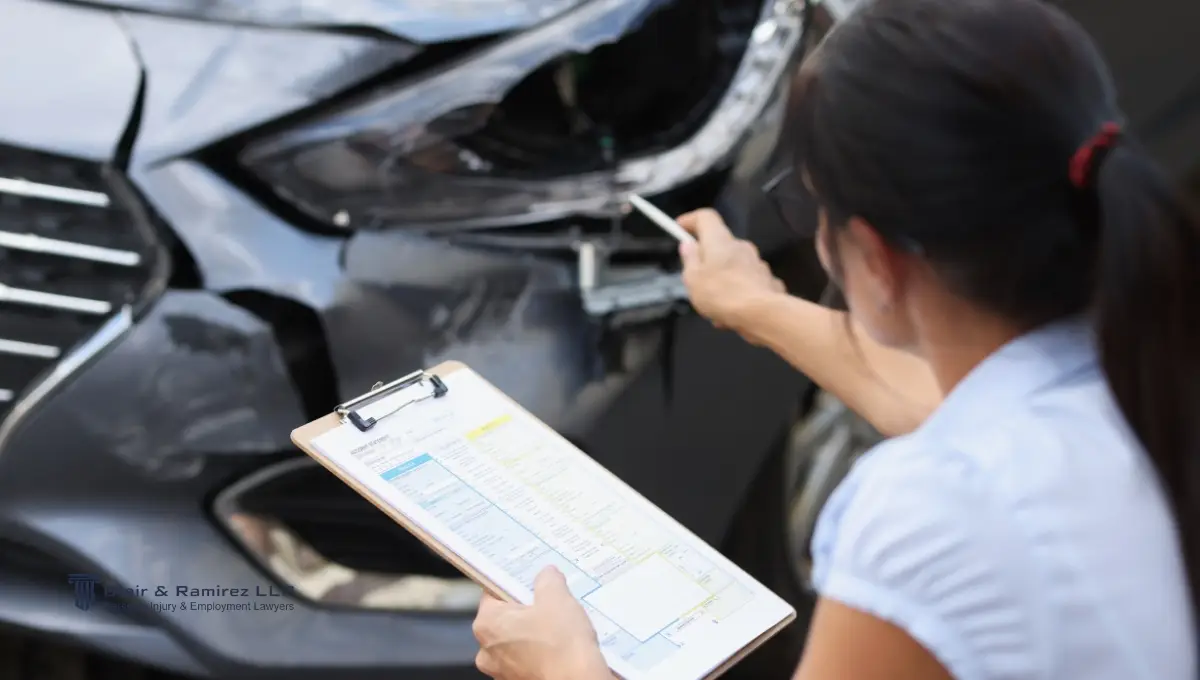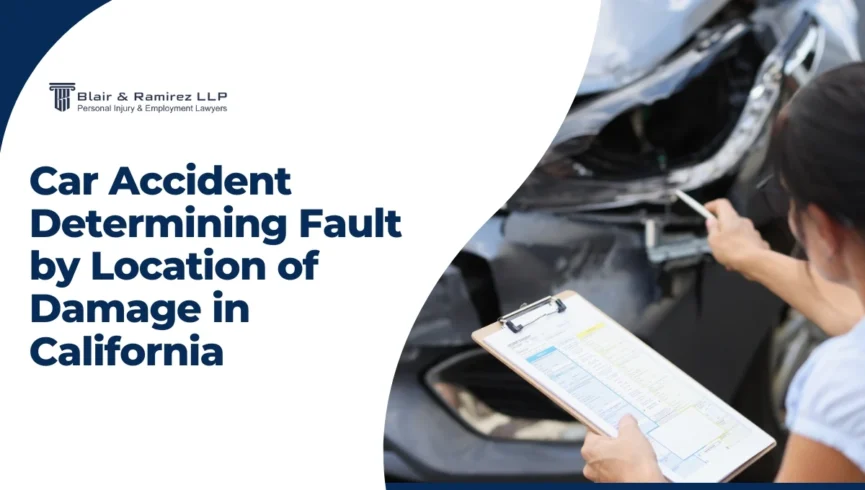After a collision, every dent, scrape, and crush pattern tells part of the story. In California, police, insurance adjusters, and attorneys closely examine this damage to piece together how the crash happened but it’s never the only deciding factor.
At Blair & Ramirez LLP, we know how to turn these clues into powerful evidence. By pairing damage analysis with eyewitness testimony, traffic law knowledge, and expert accident reconstruction, we build a case that puts you in the strongest position possible. If your fault is being judged by the location of your vehicle’s damage, our team will protect your rights, challenge unfair conclusions, and fight to maximize your compensation.
How Damage Location Helps Determine Fault in California Car Accidents
In California accident cases, from Los Angeles to Bakersfield, the location of the damage often plays a key role in determining fault. Police, insurers, and courts use impact patterns to piece together events, especially when paired with other evidence to strengthen a claim.
Why Damage Location Is Key Evidence in Crash Investigations
Physical impact evidence can show where two vehicles first made contact, the angle of collision, and even their approximate speed and direction at impact. For example, a crushed front bumper can suggest a forward-moving collision, while damage concentrated on one corner might indicate a turning movement. These clues form part of the bigger picture that investigators use to establish responsibility.
California’s Legal Rules for Deciding Who Is at Fault
California follows a pure comparative fault system, meaning each party’s percentage of fault reduces their compensation by that amount. Even if you are 30% at fault, you can still recover 70% of your damages.
Fault is not determined solely by impact patterns; legal responsibility can also depend on factors such as right-of-way violations, driver negligence, or unsafe maneuvers. Under this model, a vehicle with more visible damage is not automatically the at-fault party.
Common Damage Patterns and What They Mean for Liability
Certain impact patterns often guide fault analysis:
- Front-end damage - May suggest the driver rear-ended another vehicle or failed to stop in time.
- Rear-end damage - Often linked to the trailing driver but can have exceptions.
- Side damage - May point to unsafe lane changes or intersection violations.
How the Initial Point of Contact Shapes Fault Decisions
Investigators pay close attention to the first area of impact because it often reveals who had the right-of-way or made the last movement before the collision. This detail can heavily influence final fault decisions in California accident cases.
Crash Types and What Damage Location Says About Fault
Rear-End Collisions and When the Back Driver Isn’t at Fault
Most people assume the driver in the back is always at fault in a rear-end collision. While this is often true, there are clear exceptions. For example, if the lead driver brake-checks another vehicle without reason, cuts in too closely from another lane, or stops suddenly due to an obstacle they created, fault may shift. In multi-car pileups, the chain of impacts can make it difficult to determine which driver started the crash. That’s why investigators often rely on skid marks, witness statements, and dashcam footage to confirm the true sequence of events.

Side-Swipe Collisions and Lane Change or Merge Liability
Damage along the side panels of a car often points to a lane change or merge gone wrong. Determining fault depends on which vehicle crossed into the other’s lane. Evidence such as the exact position of the damage, mirror contact, and lane markings can clarify which driver failed to check a blind spot or yield space. For example, a driver drifting across a solid lane divider into moving traffic could be found at fault even if both cars have similar scrape marks.
T-Bone Crashes at Intersections and Right-of-Way Violations
In a T-bone collision, one vehicle’s front hits another vehicle’s side. These crashes often occur at intersections and are closely tied to right-of-way violations. If one driver runs a red light, fails to stop at a stop sign, or makes an unsafe left turn, the damage pattern can match their traffic violation. For instance, a car with severe driver-side damage at a four-way stop may have been struck by someone who failed to yield.
Head-On Collisions and Identifying the At-Fault Driver
When both cars exhibit front-end damage, investigators look for clues such as tire tracks, road curvature, and eyewitness accounts to determine which driver left their lane. In California, crossing the center line without cause, especially on a curve or into oncoming traffic, is a strong indicator of fault, even if both vehicles appear equally damaged.
How Experts Analyze Damage Location in California Accident Case
In many California accident claims, whether in Los Angeles, Bakersfield, or other cities, vehicle photos alone aren’t enough to determine fault. That’s why lawyers often work with accident reconstruction experts who apply physics, engineering, and specialized tools to uncover the truth. These professionals can measure the direction, speed, and force of a collision from the damage patterns, helping to verify or dispute fault assignments. Their work transforms damaged evidence into reliable conclusions that can hold up in court or in negotiations.
Understanding Energy Transfer and Vehicle Deformation
When two vehicles collide, the impact force travels through the frame and body in predictable ways. This transfer of energy leaves measurable deformation that reveals key crash details:
- Crush depth and spread – helps estimate the vehicle's speed at impact.
- Material distortion patterns – show the exact point and angle where the force entered.
Using Crash Simulations to Reconstruct an Accident
Experts often use advanced computer simulations to recreate collisions, taking into account the vehicles’ size, weight, and speed. By matching simulated damage to the real-world photos, they can confirm or challenge an insurer’s interpretation. For instance, a simulation might reveal that “minor” bumper damage resulted from a higher-speed impact, contradicting the opposing party’s claim.
How Forensic Engineers Read Damage Patterns
Forensic engineers follow a methodical process to connect physical damage with likely crash events:
- Measure and document each damaged section precisely.
- Compare the patterns to standardized crash test data.
- Correlate results with scene evidence such as skid marks, debris placement, and witness accounts.

How Police, Lawyers, and Insurance Use Damage Location to Decide Fault
In California accident cases, the same evidence of damage can be interpreted differently depending on who reviews it. Police, insurance adjusters, and attorneys each apply their standards and priorities when determining what the damage means in terms of fault. Understanding these perspectives can help you anticipate and respond to the conclusions they may draw.
Police Accident Reports and Mapping the Impact Zone
When officers respond to a crash, they document the location of vehicle damage in official reports. They may create diagrams showing the positions of vehicles and measure skid marks to determine the point of impact. These details become part of the permanent accident record and can influence how insurers and courts view fault.
Insurance Adjuster Methods for Analyzing Damage
Insurance adjusters typically follow a three-step process when using damage location to decide fault:
- Review photos submitted by drivers or taken at the scene.
- Inspect the vehicle in person to confirm visible and hidden damage.
- Compare findings to the accident description to see if they align.
How Accident Reconstruction Experts Build the Case
Attorneys often bring in accident reconstruction experts to prepare a detailed report of the accident. This report usually combines:
- Physical evidence from the vehicles and the crash scene.
- Witness statements that describe the collision sequence.
- Computer simulations that recreate the impact and confirm damage interpretations.
Using Dashcam and Security Camera Footage in California Claims
Dashcam and surveillance footage can provide a clear, time-stamped view of an accident. Experts use this technology to verify whether the damage location matches the actual sequence of events. In some cases, 3D modeling of the footage enables precise measurements that either strengthen or dispute fault conclusions.
How Insurance Companies in California Judge Fault by Damage Location
Internal Claim Review Procedures for Damage Analysis
Most insurers follow a structured process when using damage location in fault decisions:
- Collect images from the scene or through an inspection.
- Review the claim description to see if it aligns with the visible damage.
- Consult in-house experts or databases to match patterns with known collision types.
- Apply policy guidelines to assign or share fault percentages.
- Document findings in the claim file for legal and internal review.
Situations Where Insurance Ignores Damage Location
There are cases where insurers give more weight to other evidence than to patterns of damage.
- Example 1: A dashcam video clearly shows the other driver running a red light, making damage analysis less relevant.
- Example 2: Multiple credible witnesses confirm a vehicle was rear-ended after another driver cut in suddenly, even though the damage location might suggest shared fault.
Role of Independent Adjusters in Disputed California Claims
When there is disagreement over fault, independent adjusters may be brought in to review the case. Unlike in-house adjusters, they are hired to provide an unbiased opinion and may reach a different conclusion if they interpret the damage and supporting evidence differently.
Limitations of Using Damage Location to Prove Fault in California
Damage photos alone can be misleading in California car accident cases. While they may seem to tell a clear story, they often miss the full context, such as how the crash occurred, contributing factors, or whether other forces influenced the impact. Relying solely on appearance instead of combining damage analysis with scientific and digital evidence can lead to incorrect fault assignments and costly legal consequences.
Old Damage That Confuses New Accident Claims
Prior unrepaired damage can make it appear as if a new crash caused certain dents or scrapes. For example, a car with a year-old rear bumper dent could be struck again in a different area. Yet, the insurer might mistakenly attribute all the visible damage to the latest collision.
Multi-Car Pileups and Mixed Damage Patterns
In chain-reaction accidents, overlapping impacts can blur the sequence of events. Challenges include:
- Multiple vehicles hitting each other from different angles.
- Secondary collisions altering the original damage.
- Debris from one car striking another, creating misleading marks.
Mechanical Failures That Produce Misleading Damage Patterns
Brake failure or steering malfunctions can cause unusual impact signatures that don’t match typical crash scenarios. Without expert analysis, this can lead to incorrect assumptions about driver error.
Fake Accidents and Staged Damage Scenarios
In rare cases, collisions are intentionally staged to collect insurance payouts. For instance, a fraudster might damage a vehicle in a controlled setting, then claim it was the result of a legitimate accident. Such setups often require expert investigation to uncover the truth.
Steps to Protect Your Legal Rights When Fault Is Determined by Damage Location
When the location of vehicle damage plays a central role in deciding fault, proactive evidence collection and expert input can make all the difference. Acting quickly helps preserve proof, strengthen your position, and counter inaccurate conclusions from insurers or opposing parties.
Taking Clear Photos of Your Car After the Crash
To preserve valuable evidence:
- Photograph the entire vehicle from multiple angles.
- Get close-up shots of all damage areas.
- Include surrounding road conditions and skid marks.
- Take photos in good lighting or use a flashlight if needed.
- Capture the other vehicle(s) involved for comparison.
Preserving Paint Transfer and Impact Marks
Paint transfers, crush zones, and specific impact angles can reveal how two vehicles made contact. Crash experts study these details to determine collision direction and speed, which can either support or challenge damage-based fault claims.
Getting an Independent Accident Expert’s Report
An independent reconstruction specialist can provide an unbiased analysis of the crash. This helps by:
- Offering a professional opinion not tied to the insurance company.
- Using advanced tools and testing to confirm or dispute the official fault determination.
How Damage Location Can Affect Your Compensation in California
In California, the way damage evidence is interpreted can directly impact your settlement. If it supports your version of events, it can strengthen your claim; if misread, it can lower your payout. Compensation is tied to fault percentages under state law, so accurate damage analysis is critical.
California’s Comparative Negligence Rules Explained
California uses a pure comparative negligence system. This means your compensation is reduced by your percentage of fault, regardless of how small it may be. For example:
| Fault Percentage | Total Damages | Final Payout |
|---|---|---|
| 0% | $100,000 | $100,000 |
| 25% | $100,000 | $75,000 |
| 50% | $100,000 | $50,000 |
Even if you are found 80% at fault, you can still recover 20% of your losses. Because the location of damage can influence these fault percentages, having the right evidence is crucial for maximizing recovery.
How State Laws Affect Settlement Amounts
Settlement values can also be shaped by:
- Statutory limits - Certain damages, such as claims against government agencies, are subject to caps.
- Case precedents - Prior court rulings can influence how similar damage evidence is treated.
- Policy minimums - State-required insurance coverage levels may limit the maximum payout, even if damages exceed that amount.
Understanding how these legal factors interact with fault findings based on damage location can help you and your attorney pursue the best possible outcome.
Common Misconceptions About Fault Based on Damage Location
Many drivers assume that where a vehicle is damaged is all that’s needed to prove fault. In reality, damage location is just one part of the story, and relying on it alone can lead to inaccurate conclusions. Two common misconceptions often cause problems in California accident cases.
Why Damage Location Alone Doesn’t Always Prove Fault
Other evidence, such as traffic laws, driver actions, and witness accounts, can completely change the fault analysis. For example, a car hit in the rear might seem blameless, but if dashcam footage shows it reversing suddenly without warning, the conclusion shifts.
Ignoring Witness Statements and Traffic Camera Footage
Leaving out credible witness statements or traffic camera evidence can lead to distorted fault findings. These sources can confirm whether the damage matches the crash sequence or reveal entirely different causes. In California, this supporting evidence often carries more weight than visual inspection alone.

How to Dispute a Fault Decision Based on Damage Location
Challenging a fault determination that’s based mainly on vehicle damage requires a strategic approach. Gathering additional evidence, getting expert analysis, and sometimes involving an attorney can help correct errors and protect your right to fair compensation in California.
Using Extra Evidence to Challenge an Insurance Claim
Strong evidence can shift the outcome of a disputed claim. Useful proof includes:
- Clear, high-quality accident scene photos.
- Independent accident reconstruction reports.
- Dashcam or security camera footage.
- Credible witness statements.
- Official police diagrams and measurements.
Deciding If You Need a California Car Accident Lawyer
You should consider hiring a lawyer if:
- Your claim has been denied or undervalued.
- The facts of the crash are being contested.
- You suffered serious injuries with high medical costs.
- You suspect the insurer is biased in its evaluation.
An experienced attorney can gather additional evidence, challenge flawed assumptions, and present a stronger case for the compensation you deserve.
FAQs About Determining Fault by Location of Damage
Wrongly Blamed After a Crash? Understanding Your Rights in California Fault Disputes
Being unfairly blamed for a car accident can significantly impact your reputation, finances, and ability to recover damages. In California, you have the right to challenge a fault decision, especially when it’s based on incomplete or incorrect damage analysis. Recognizing when to get legal help can protect both your case and your future.
You should consider contacting a Los Angeles car accident lawyer or a Bakersfield car accident lawyer if:
- Your insurance claim has been denied or significantly undervalued.
- The facts of the accident are being disputed by the other party.
- You sustained serious injuries with substantial medical expenses.
- You suspect the insurer is biased or ignoring key evidence.
At Blair & Ramirez LLP, we fight for drivers who have been wrongly blamed. Our team knows how to gather the right evidence, challenge inaccurate fault findings, and pursue the compensation you deserve.

Contact us today for a free case review and take the first step toward protecting your rights.


